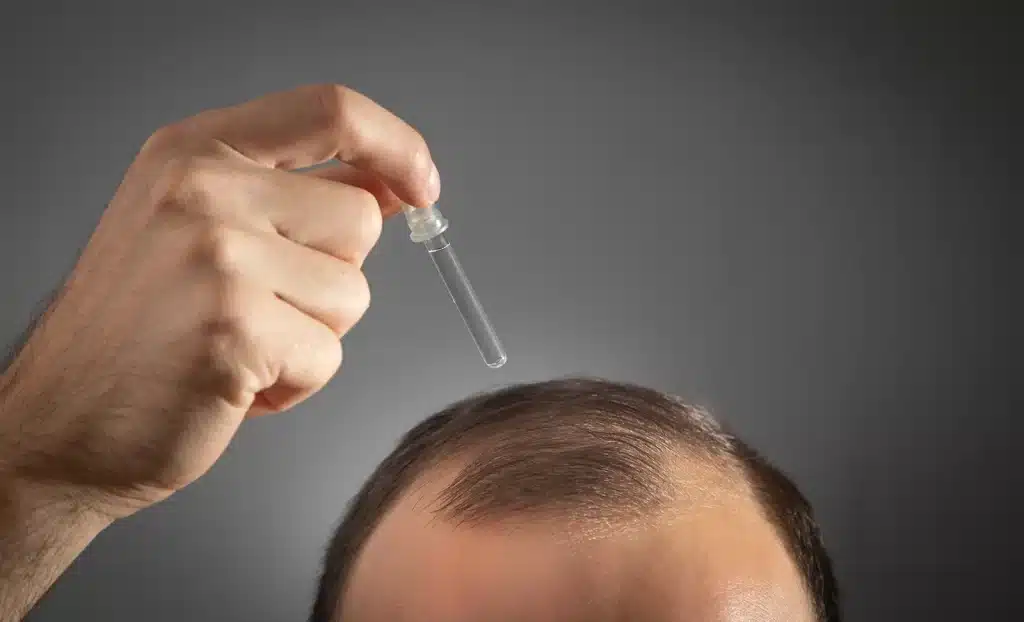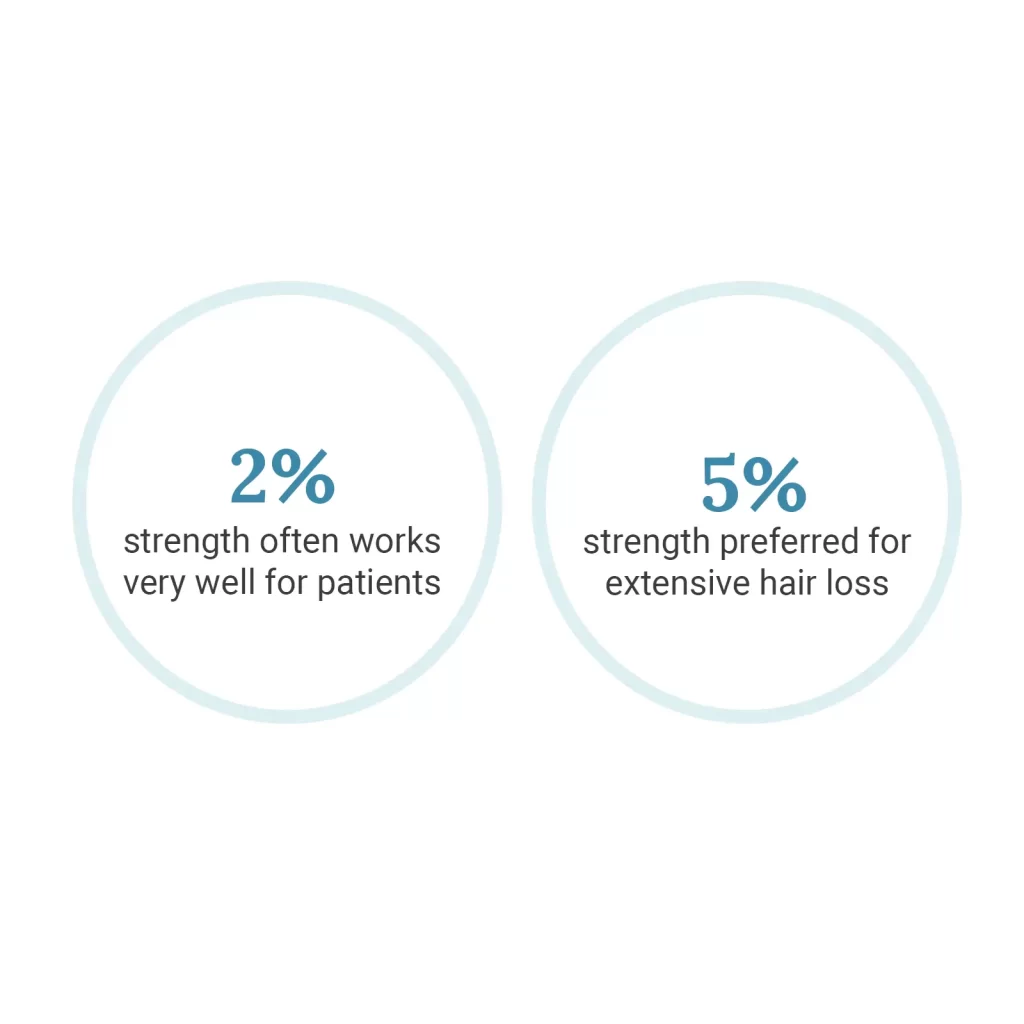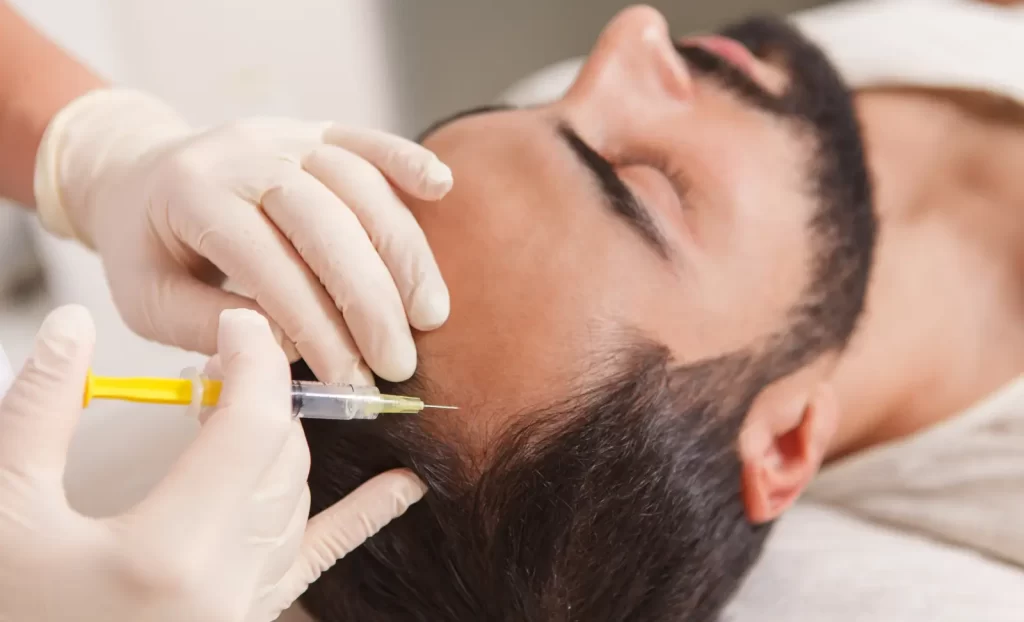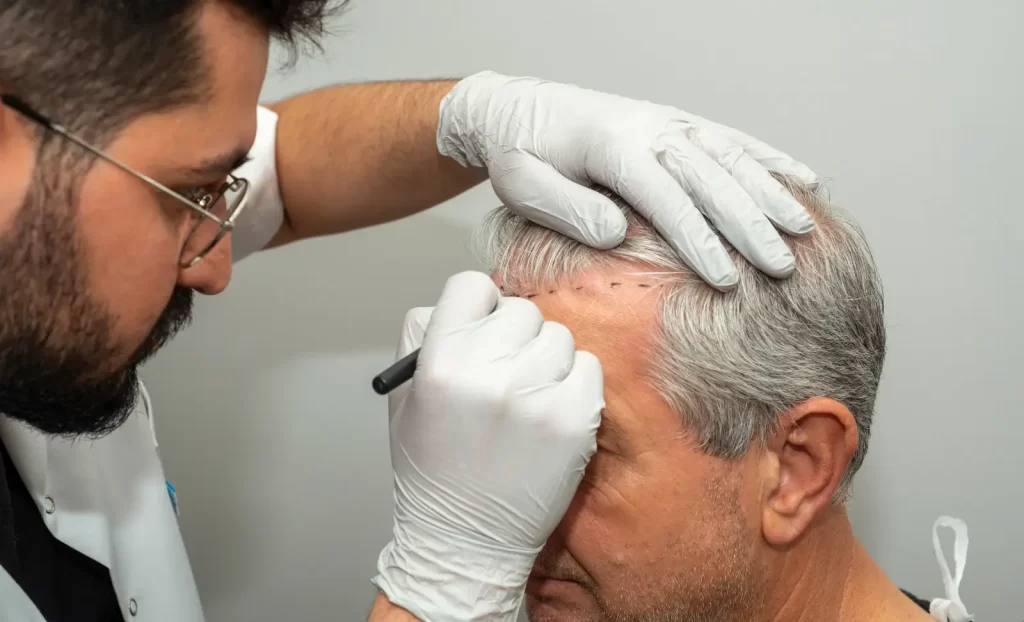A sensible step after experiencing hair loss is going to see your GP. A doctor will be able to help you understand the cause of your hair loss and potentially come up with a solution to help regrow the hair. One standard and highly effective hair loss treatment for both men and women is minoxidil.
In this article, we will answer all your burning questions about minoxidil, including whether or not you can get it as an NHS prescription.
What is Minoxidil?
First, it’s important to understand that minoxidil – while commonly known as a hair loss treatment – isn’t all about the hair. In fact, it was initially created to treat high blood pressure. Since then, it was found that minoxidil also positively affected the hair’s roots, increasing blood flow, widening the hair follicles, and prolonging the anagen phase of hair growth. [1]
How Effective is Minoxidil for Hair Regrowth?
Over the years, many studies have shown just how impactful regular use of minoxidil is for people experiencing hair loss. It works for both men and women, too (unlike some other treatments, such as finasteride). In one study, six months of treatment saw significant improvement in hair density in patients taking either oral or topical minoxidil, with over 60% of participants stating that they were satisfied with the results of the treatments. [2]
As you can see, minoxidil is genuinely effective, which is why so many doctors recommend it.
Can You Get Minoxidil for Hair Loss on the NHS?
Unfortunately, no – minoxidil for hair loss cannot be prescribed on the NHS. This is because it’s classed as an aesthetic treatment rather than a medical issue. The NHS does prescribe oral minoxidil to certain patients, but that’s if the prescription is for managing blood pressure.
The good news is that minoxidil UK is really easy to get without a prescription. Minoxidil for women and men is available over the counter at most UK pharmacies, and while NHS doctors cannot prescribe it, many of them do recommend it to their patients. Cost varies depending on dosage and brand, but you can usually get a one-month supply for under £20.
It’s Still Worth Speaking to Your GP
Even though minoxidil cannot be prescribed by an NHS GP, it’s still worth talking to your doctor before using it. Minoxidil isn’t for everyone. If you have certain allergies or are taking certain medications, your doctor may advise against using them.
How to Use Minoxidil
The first step is deciding on a strength, which you can discuss in full with your doctor or pharmacist. There are two doses of minoxidil: 2% and 5%. The 2% strength often works very well for patients, but if you have extensive hair loss, you may prefer the 5% strength option. Generally, it’s best to start low and go higher if you need to.
Your minoxidil treatment should include very clear instructions on how to apply it. Minoxidil usually comes in the form of a liquid or a foam, and you need to apply it topically to the scalp once per day. Most topical solutions should be left on for around four hours before washing it out.
Using it Regularly
One of the most important things when it comes to using minoxidil is that you do it regularly. The results will only last as long as you keep using the treatment. If you use minoxidil for a year, see great results, and then stop, then your hair will return to how it was before you’d ever started treatment.
How Long Does It Take to See Results?
It should take around four months to see visible results from minoxidil, but it can take longer for some patients. As a general rule, it’s best to use minoxidil for at least twelve months before deciding whether or not to continue usage, and using something like a hair track app can help you see whether results are coming through or not. If you haven’t seen any hair growth in twelve months, the chances are the treatment simply does not work for you.
Potential Side Effects
Like with any medication, there is the possibility of side effects after taking minoxidil. Luckily, these side effects are often mild, but it’s still important to be aware of them beforehand. Here they are:
- Itchiness
- A Rash
- Scalp Burning
- Inflammation
- Redness
- Swelling
- Hair Loss
Some of these symptoms are more common than others. For example, people are more likely to experience itching than swelling or minoxidil hair loss. If you’re worried about any of the symptoms, you can discuss it with your doctor and pharmacist. If you do experience any of the symptoms, you should discontinue using minoxidil.
Is Minoxidil Right for You?
While minoxidil has a high success rate for people experiencing male or female pattern baldness, that doesn’t mean it’s for everyone. If any of the following apply to you, you will want to look at alternative hair regrowth options:
- You Are Pregnant or Breastfeeding
- You Have Psoriasis or Eczema on the Scalp
- You’re Allergic to an Ingredient in Minoxidil
- You Have a Wound on Your Scalp
- You’re Younger than 18 or Older than 65F2
- You’re Taking a Medication that Doesn’t Mix Well with Minoxidil
As mentioned earlier, it’s best to speak with your doctor before taking minoxidil so you can be sure that it’s the proper treatment for you. Don’t worry – if you conclude that minoxidil simply won’t work with your scalp, whether that’s because you have scalp psoriasis or you’re not quite the right age, there are other methods that can help you regrow your hair!
Other Hair Restoration Treatments
If you have a history of hair loss and minoxidil isn’t the right treatment for you, there are other options.
Finasteride
Finasteride is another hair loss medication, only this one is only for men. You need an NHS prescription to get hold of this medication, and it’s taken orally. The reason it only works for men is that it blocks the male hormone DHT, which is often responsible for male pattern baldness.
Steroid Injections
Another popular treatment for hair loss is steroid injections. These injections are administered directly into the balding area of the scalp. Usually, you can begin seeing results from these injections within six weeks, but remember, they won’t work for everybody.
Steroid Creams
Steroid creams work similarly to steroid injections, only they are applied topically. Like with the injections, this treatment works for some, but not everyone.
Light Treatment
Low-Level-Light-Therapy is an effective and widely used hair restoration treatment many clinics offer patients. You will need several appointments for it to work. Usually, treatment lasts around six months. [3]
Hair Transplants
A hair transplant can completely transform your hair. They have come a long way since the days of the hair plugs. Nowadays, doctors can transplant individual follicles from one area of the scalp to another (via the FUE method), resulting in a very natural result. They are undoubtedly more expensive than some other treatment options, but hair transplants last forever, making them worth it for many people.
Combining Minoxidil with Other Hair Restoration Treatments
Minoxidil for hair loss is, without a doubt, an excellent way to regrow hair and has already helped thousands of men and women. It doesn’t have to be taken alone, though, as many people enjoy even better results when mixing minoxidil with another hair loss solution.
One example is minoxidil and finasteride. Both of these medications are common for treating male pattern baldness, and when used together, they can have an even better effect on hair regrowth, as demonstrated by one study involving 50 male patients. [4]
It’s also common for those who’ve had a hair transplant to use minoxidil after the transplant. Doing this is a good way of stimulating hair growth, and it could even improve the results of the hair transplant overall. If you do get a hair transplant, it’s best to speak to your doctor/surgeon about any medical treatments you should follow the procedure up with.
Should You Get a Hair Transplant?
Using topical minoxidil is an easy decision—your biggest worry is perhaps an allergic reaction. On the other hand, deciding to get a hair transplant is a big deal. It’s a surgical procedure, after all. Is it something you should consider?
If you’ve experienced male or female pattern baldness and other treatments don’t seem to work, a hair transplant could transform your hair—and your life. They are highly effective and give results that last a lifetime.
In Summary
Minoxidil for hair loss is not available on the NHS. If you want to use minoxidil to regrow your hair, you’ll need to get it over the counter at your local pharmacy. It’s a very effective method for hair restoration, so if you’ve experienced bald patches or thinning hair, it’s worth trying.
Remember, there are other hair restoration options if minoxidil doesn’t seem to work for your scalp. If you’re interested in the hair loss treatments we offer here at Harley Street Hair Clinic, get in touch with the friendly team today. You can also check out our patients gallery to see the kind of transformations we can offer.
Sources:
- https://pubmed.ncbi.nlm.nih.gov/14996087/#:~:text=Minoxidil%20may%20also%20cause%20prolongation,opener%20of%20sarcolemmal%20KATP%20channels.
- https://onlinelibrary.wiley.com/doi/full/10.1111/jocd.16086
- https://www.ncbi.nlm.nih.gov/pmc/articles/PMC8906269/#:~:text=The%20most%20commonly%20used%20devices,a%20week%20for%206%20months.
- https://www.ncbi.nlm.nih.gov/pmc/articles/PMC4314881/






